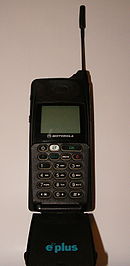Motorola 8900
The Motorola 8900 (also known as the E-Plus Traveler ) is the first dual-band mobile phone produced by Motorola . It was manufactured in 1997.
The device is characterized above all by the "network standard" button, which allows a manual change from GSM 900 to DCS 1800 .
With dimensions of 139 × 58 × 26 mm (179 × 58 × 26 mm unfolded) it has a weight of 218 grams. The original battery is a 6 V Nickel-MH battery with an unknown capacity. The device has around 4.5 hours of talk time and 85 hours of standby time. It has a fully graphic B / W screen to display text and logos. The integrated memory is sufficient for 100 phone book entries, in addition to the SIM card space .
The flap is used to protect the keyboard. When it is closed, the key lock is activated. When you receive a call, the call is accepted by opening it and closed again by closing it. The extendable antenna is 83 mm long in total, but only 23 mm when not extended.
A DIN-1 SIM card is inserted, which is inserted into the device from below and can be changed without switching off the phone or removing the battery.
Range of functions
- Vibration alert
- 11 rings (standard tone, single ring tone, British ring tone, German ring tone, Bravor ring tone, triple ring tone, siren, fast ring tone, high ring tone, music ring tone)
- Network change button (GSM 900 ← / → DCS 1800)
- Phonebook with 100 entries on the phone
- Side buttons for volume adjustment
- Mute button
- Eject switch for the SIM card
- Cover to protect the keyboard and to accept calls
- Screen backlight
- Message editor for receiving and sending SMS
- Extendable antenna to improve reception
- Call charge management
- Speed dial key for the mailbox
- With the optional Motorola computer cable, the 8900 can also be used as a modem
